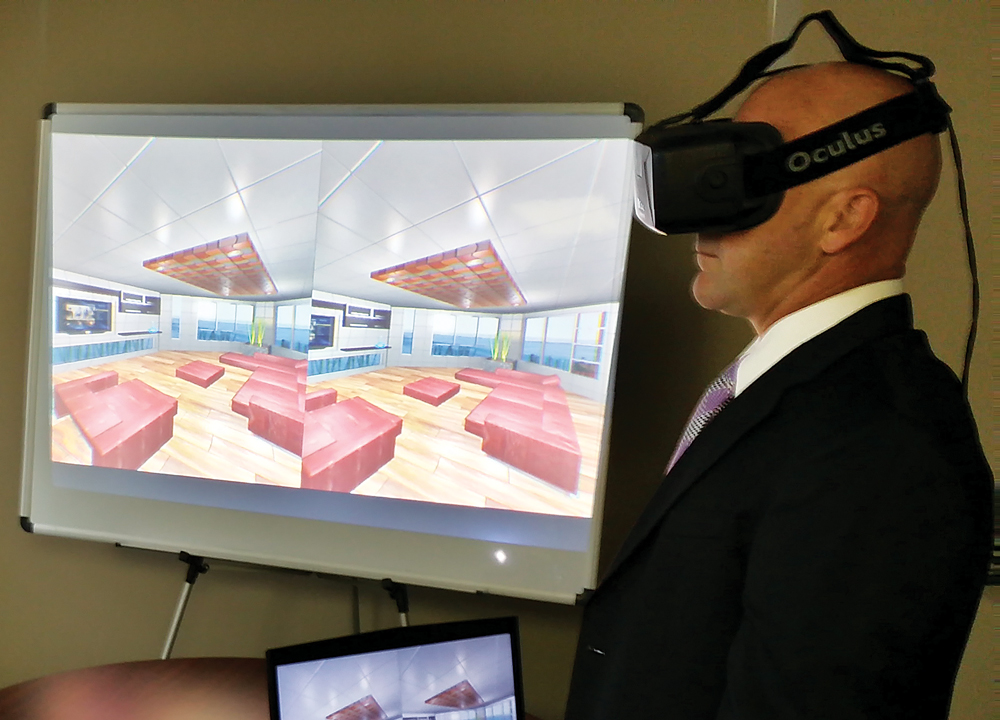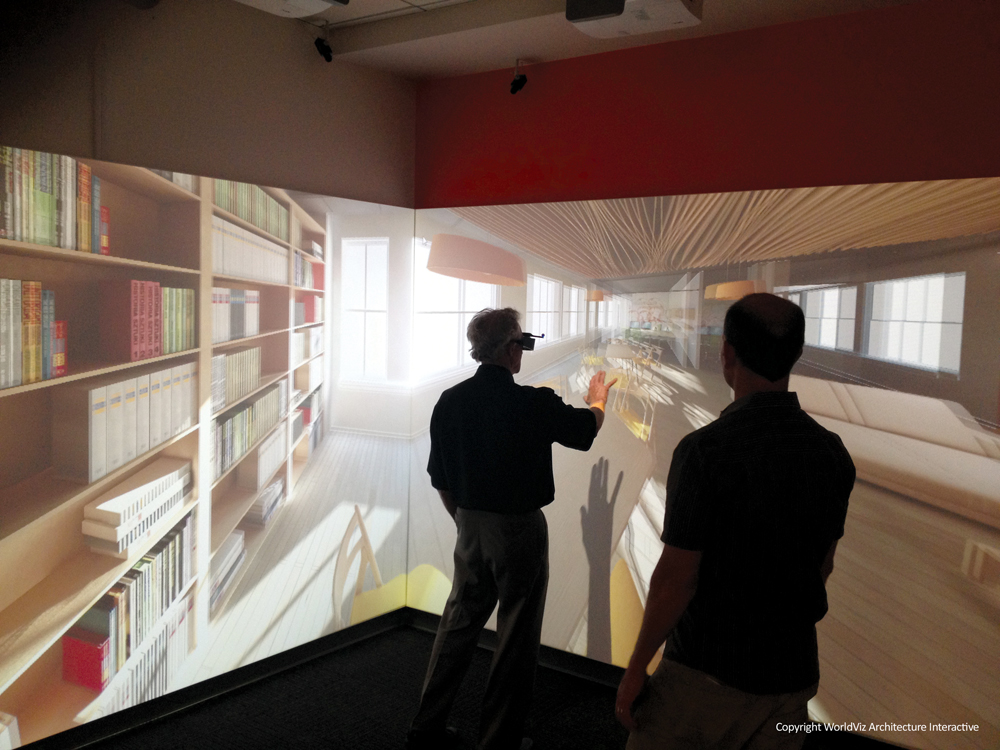When Facebook announced this past March that it was buying Oculus VR for a reported $2 billion, it signaled the beginning of a new movement in the U.S. tech sector—virtual reality for the masses.
One of the most successful Kickstarter campaigns to date—raising some $2.4 million from 9,522 investors in 2012—Oculus VR aimed to shake up the highly specialized, cost-prohibitive virtual reality hardware market by offering a low-cost, plug-and-play VR headset geared for gamers.
At $350, the Oculus Rift was a fraction of the cost of competing hardware solutions at the time (several similarly priced systems have since been launched), and a tiny sliver of the cost of fully loaded CAVE (computer-assisted virtual reality) systems and VR simulators popular in the military and scientific communities, which can run in the $20,000-30,000 range.
With Mark Zuckerberg’s deep pockets behind the technology, it won’t be long before every gamer is fully immersed in VR environments. “Oculus has the chance to create the most social platform ever, and change the way we work, play, and communicate,” said Facebook’s founder.
The technology is a natural fit for the AEC industry. Many firms are already building highly detailed BIM/VDC models of their most complex projects, so VR looks like the logical next step.
“Most people—including many in our industry—cannot read plans very well, so there are huge benefits in visualizing the design,” says Christopher Rippingham, BIM Manager and Construction Technology Specialist at DPR Construction. The firm is one of the industry’s early adopters of fully immersive VR modeling, operating a full-service VR showroom at its Redwood City, Calif., headquarters.
What you'll need to host truly immersive VR sessions
VR Headset or CAVE System
There are two approaches to creating a fully immersive VR experience: surround the users with a series of screens or projections, known as a CAVE (computer-assisted virtual environment), or have them wear headsets. Headsets are much less costly—the Oculus Rift starts at $350. Advanced 3D TVs and computer monitors can also be used, but the experience will be less immersive.Beefed-up Workstation
VR sessions require tremendous processing power. Attempting to host a VR session on a MacBook Pro will likely result in a choppy, sluggish experience for the user. VR technology provider WorldViz recommends that VR workstations have an i5 or i7 processor with high clock speed, at least 8 gigabytes of RAM, and a dedicated graphics card.Advanced Controller
For power users, a keyboard will suffice for navigating a VR model. Not so for novices, especially clients. Our experts advise you to look into the many gaming controllers, data gloves, hybrid keyboards, joy sticks, and other VR controllers on the market. They’re relatively inexpensive and can greatly enhance the user experience and productivity during VR sessions.Dedicated Showroom Space
The beauty of modern VR headset technology is its portability. Sessions can be held virtually anywhere—at a client’s office, a Building Team co-location site, even the job site. Our VR experts recommend creating a dedicated showroom area for VR sessions, with ample, professional-looking space, a powerful workstation, and all the tools and accessories needed to create a great experience for clients.Accessories
VR technology firm PocketCake offers a mobile workstation, the VRSCA, that allows up to eight persons to navigate a VR model simultaneously for group coordination meetings or guided tours. WorldViz sells standard and custom avatars that can be placed in VR models to make the spaces more lifelike. The firm also offers a 3D sound system for more realistic acoustics.
There, DPR worked with VR technology provider WorldViz to install a corner CAVE (with multiple projections to create a 90-degree view) and a fully immersive, headset-based walkable VR environment. The firm has used advanced VR for several applications, including constructability reviews and virtual mockups.
“The technology helps us drive a more predictable outcome for clients, whether that’s the look and feel of a design or a specific detail that is going to be constructed,” says Rippingham. The ability to immerse clients in the space they’re eventually going to occupy “helps generate excitement and creates a volunteer army to help us with some of the issues we need to tackle,” he says.
Suffolk Construction doesn’t have an in-house VR studio, but the firm has applied advanced VR on several projects to date, most recently on the Brigham and Women’s Hospital’s 620,000-sf, 13-story Brigham Building for the Future, currently under construction in Boston.
“As an experiment, we modeled the entire project and had the doctors and support staff walk through the proposed spaces using a CAVE environment,” says Peter Campot, the firm’s Chief Innovation Officer and President of Healthcare, Science and Technology. “We told them that they could change anything they wanted during a two-week review period, but after that they could only change colors. We got tremendous buy-in, and there have been minimal changes so far.”
By using VR, Suffolk has almost completely eliminated physical mockups on select healthcare and S+T projects, while greatly reducing change orders—resulting in considerable savings.
“We’re looking at a process of walking every client through a project virtually before we build it,” says Campot. “Nine times out of ten, the reason they have changes is due to the client not understanding what they agreed to. If we can walk them through that, we eliminate that unknown.”
Campot and Rippingham identified five solid applications for VR in the AEC field:
Virtual mockups. VR reduces the need for costly physical mockups and can be a more effective tool. Virtual mockups can be tweaked based on user input relatively quickly and retested in an iterative design process. “You can refine the details much faster,” says Rippingham.
Constructability reviews. The technology offers a much richer environment for hashing out the details on the problematic components of a job. “We’re getting away from the ‘figure it out in the field’ mentality,” says Campot. “It all starts with getting it right in the model.”
Facilities operations training. Even before the building is completed, the Building Team can walk the facilities management staff through the inner workings of the design, conduct basic training on the systems and equipment, and gather feedback for improvement.

An architect at AECOM’s Kansas City, Mo., office experiences a virtual reality simulation of a high-rise condo design concept. VR technology provider PocketCake created the VR model and powered the demonstration using its VRSCA mobile workstation and the Oculus Rift headset. PHOTO: COURTESY POCKETCAKE
Safety hazard analysis. “We’re putting our teams into the virtual reality environment so that they can more effectively analyze projects for fall hazards and other potential safety issues,” says Rippingham.
Real estate sales and marketing. VR can be a powerful tool for commercial real estate developers in preselling their space, especially on speculative office and condominium projects, where presales can greatly affect financing.
5 VALUABLE TIPS FROM EARLY ADOPTERS
Here’s some helpful advice from our experts on implementing VR in your firm:
1. Define the desired outcomes up front. Manage client expectations, says DPR’s Rippingham: “When a client says they want to look at their space in a virtual reality environment, we ask them what they’re trying to achieve and we make sure they’re aware of the level of effort required for each use.”
2. Be prepared for extra work—and costs—to create the VR model. You can’t just throw Oculus Rift on your BIM model and start navigating. The BIM model needs to be converted for VR use, which takes time and may require the expertise of a third-party specialist.
“This is a limiting factor due to the fast pace in which designs evolve on most projects,” says Tim Meyers, Designer with 360 Architecture. “The technology seems to be improving rapidly and may eventually be integrated with our current design tools so that we [will be] able to use it more efficiently on projects.”
3. Designate a tour guide for client sessions. Clients can easily get lost or disorientated when attempting to navigate a VR model solo. Look into VR setups that can accommodate multiple users simultaneously.
4. Beware of motion sickness, especially with the headset. Have people walk or move slowly through the model to avoid queasiness, advises Campot. The last thing you need is to get your client nauseous.
5. Consider adding avatars to the models. This is especially helpful for virtual mockup applications; for example, a surgeon avatar could simulate the steps required to conduct a procedure in an OR. “We didn’t do that initially and quickly realized it has a tremendous amount of value,” says Campot. “The client’s level of understanding of the space starts to kick in when they can test out the space for safety and efficiency by simulating procedures.”
Related Stories
| Aug 11, 2010
Callison, MulvannyG2 among nation's largest retail design firms, according to BD+C's Giants 300 report
A ranking of the Top 75 Retail Design Firms based on Building Design+Construction's 2009 Giants 300 survey. For more Giants 300 rankings, visit http://www.BDCnetwork.com/Giants
| Aug 11, 2010
USGBC honors Brad Pitt's Make It Right New Orleans as the ‘largest and greenest single-family community in the world’
U.S. Green Building Council President, CEO and Founding Chair Rick Fedrizzi today declared that the neighborhood being built by Make It Right New Orleans, the post-Katrina housing initiative launched by actor Brad Pitt, is the “largest and greenest community of single-family homes in the world” at the annual Clinton Global Initiative meeting in New York.
| Aug 11, 2010
AIA report estimates up to 270,000 construction industry jobs could be created if the American Clean Energy Security Act is passed
With the encouragement of Senate majority leader Harry Reid (D-NV), the American Institute of Architects (AIA) conducted a study to determine how many jobs in the design and construction industry could be created if the American Clean Energy Security Act (H.R. 2454; also known as the Waxman-Markey Bill) is enacted.
| Aug 11, 2010
Architect Michael Graves to be inducted into the N.J. Hall of Fame
Architect Michael Graves of Princeton, N.J., being inducted into the N.J. Hall of Fame.
| Aug 11, 2010
Modest rebound in Architecture Billings Index
Following a drop of nearly three points, the Architecture Billings Index (ABI) nudged up almost two points in February. As a leading economic indicator of construction activity, the ABI reflects the approximate nine to twelve month lag time between architecture billings and construction spending.
| Aug 11, 2010
Architecture firms NBBJ and Chan Krieger Sieniewicz announce merger
NBBJ, a global architecture and design firm, and Chan Krieger Sieniewicz, internationally-known for urban design and architecture excellence, announced a merger of the two firms.
| Aug 11, 2010
Nation's first set of green building model codes and standards announced
The International Code Council (ICC), the American Society of Heating, Refrigerating and Air Conditioning Engineers (ASHRAE), the U.S. Green Building Council (USGBC), and the Illuminating Engineering Society of North America (IES) announce the launch of the International Green Construction Code (IGCC), representing the merger of two national efforts to develop adoptable and enforceable green building codes.
| Aug 11, 2010
David Rockwell unveils set for upcoming Oscar show
The Academy of Motion Picture Arts and Sciences and 82nd Academy Awards® production designer David Rockwell unveiled the set for the upcoming Oscar show.







